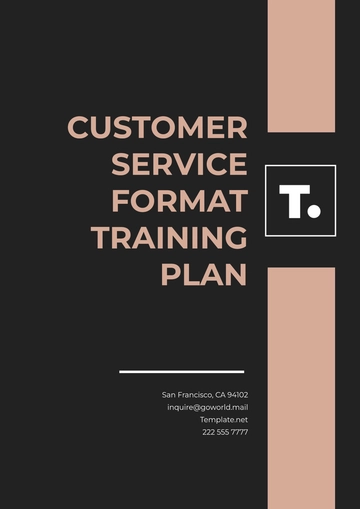Free Printable Gamified Training Plan

I. Introduction
Gamified training uses game-based elements to transform the learning experience. Integrating fun and interactive components, it boosts learner engagement and motivation while achieving meaningful learning outcomes. This plan outlines a strategic approach to deploying gamified training that ensures success across various environments and audiences.
II. Objectives
The primary goals of this gamified training initiative are:
Increase learner motivation and engagement: Encourage active participation through dynamic and personalized game mechanics.
Improve knowledge retention: Leverage repeated exposure and challenges to reinforce key concepts.
Enhance skill acquisition: Facilitate hands-on learning and real-world application of skills.
Facilitate real-time feedback and assessment: Offer immediate feedback to drive continuous improvement.
III. Training Elements
To maximize effectiveness, the gamified training will include the following components:
A. Game Mechanics
Incorporating game mechanics ensures participants are motivated and invested in the training process. Key elements include:
Points and Scoring System: Reward participants for completing tasks and reaching milestones.
Badges and Achievements: Celebrate accomplishments and skills acquired during the training.
Leaderboards: Create healthy competition through rankings and progress tracking.
Levels and Progression: Implement tiered learning that rewards learners as they advance through more challenging content.
B. Narrative and Storytelling
Integrating compelling narratives helps create an immersive experience. Develop storylines that align with the training content and engage learners in context-driven scenarios. These stories should reflect real-world applications and be adaptable to the learner's progress and choices.
C. Interactive Challenges
Active problem-solving is key to effective learning. Design challenges, simulations, and scenarios that require critical thinking, collaboration, and skill application. The challenges should progress in difficulty to maintain engagement while reinforcing learning objectives.
D. Feedback and Rewards
Real-time feedback helps learners understand their performance and areas for improvement. Incorporate instant feedback on challenges, quizzes, and tasks, coupled with motivational rewards like points, badges, or unlocking new levels. This encourages continued engagement and learning.
IV. Implementation Strategy
A. Target Audience Analysis
Begin by identifying the target audience and developing learner personas to comprehend their preferences, motivations, learning styles, and technological familiarity, which will assist in customizing gamified elements like narrative style, challenge difficulty, or platform preference to suit their needs.
B. Content Development
Content creation is a crucial phase to ensure the training materials align with both educational goals and gamification principles. The process involves:
Research and Planning: Identify learning objectives, audience needs, and game mechanics that best support them.
Content Creation: Develop high-quality, engaging, and educational content that supports gamified features.
Review and Feedback: Test the content with a small group of users to gain insights into its effectiveness and engagement.
Finalization and Deployment: Incorporate feedback and deploy the final version of the training program.
C. Technology Selection
Choose the right technology stack that supports gamified features and integrates seamlessly with the training process. Recommended tools include:
Technology | Features |
|---|---|
Learning Management System (LMS) | Tracks progress, integrates gamification elements and monitors user engagement. |
Mobile Applications | Provides access on the go, interactive elements for mobile learners. |
Virtual Reality (VR) | Creates immersive, simulation-based environments for experiential learning. |
Augmented Reality (AR) | Enhances the real-world context with overlaid digital elements to assist learning. |
Gamified Platforms | Platforms specifically created for educational purposes and interaction, such as Kahoot and Duolingo. |
D. Integration with Organizational Infrastructure
Ensure the gamified training platform integrates with existing systems, including HR and performance management tools. This allows seamless tracking of learner progress and outcomes.
V. Monitoring and Evaluation
A. Performance Metrics
To assess the success of the gamified training, monitor the following:
Engagement Rates: Track participation, completion rates, and time spent on training.
Knowledge Assessments: Use quizzes, tests, and skill-based challenges to evaluate learner understanding.
Completion Rates: Measure the number of learners who finish the training and progress through levels.
User Feedback: Collect qualitative and quantitative feedback to gauge satisfaction and areas for improvement.
B. Feedback and Iteration
After each training cycle, gather feedback from participants regarding their experiences with the gamified elements, content, and user interface. Use this data to continuously iterate on the training process and improve the overall experience. Key improvements might include:
Adjusting difficulty levels to match learner capabilities.
Refining storytelling and challenge scenarios based on feedback.
Enhancing technological tools or platforms based on user experience.
C. Long-Term Engagement
Design the training with long-term engagement in mind by providing periodic updates, new challenges, and additional rewards. This could involve adding new levels, seasonal events, or content updates to keep participants interested over time.
D. Scalability and Sustainability
Ensure the training program can scale with the organization’s needs and be easily adapted to future technologies. Consider modular content and a flexible platform to accommodate larger audiences and evolving training needs.
VI. Challenges and Solutions
Implementing gamified training may face challenges such as:
Technological limitations: Ensure that the chosen platforms are compatible across devices and accessible to all participants.
Learner resistance: Some learners may not respond well to gamification. Offer alternative learning paths or a balance of traditional and gamified elements.
Cost and resource constraints: While gamified training can be resource-intensive, leverage open-source tools and platforms to reduce costs. Additionally, involve subject matter experts in content creation to maintain quality.
VII. Conclusion
By strategically integrating game elements into training, this gamified approach ensures that learning is both engaging and effective. Careful planning, targeted content, and the right technology will result in enhanced learning experiences, greater knowledge retention, and improved skill acquisition. This structured plan aims to not only meet training objectives but also foster continuous growth and engagement.
- 100% Customizable, free editor
- Access 1 Million+ Templates, photo’s & graphics
- Download or share as a template
- Click and replace photos, graphics, text, backgrounds
- Resize, crop, AI write & more
- Access advanced editor
Unlock an engaging way to stay on track with Template.net’s Printable Gamified Training Plan Template! Fully customizable and editable, this template can be tailored to your unique goals. Effortlessly personalize your plan using our AI Editor Tool, adding a creative twist to your training routine while keeping you motivated and organized.
You may also like
- Finance Plan
- Construction Plan
- Sales Plan
- Development Plan
- Career Plan
- Budget Plan
- HR Plan
- Education Plan
- Transition Plan
- Work Plan
- Training Plan
- Communication Plan
- Operation Plan
- Health And Safety Plan
- Strategy Plan
- Professional Development Plan
- Advertising Plan
- Risk Management Plan
- Restaurant Plan
- School Plan
- Nursing Home Patient Care Plan
- Nursing Care Plan
- Plan Event
- Startup Plan
- Social Media Plan
- Staffing Plan
- Annual Plan
- Content Plan
- Payment Plan
- Implementation Plan
- Hotel Plan
- Workout Plan
- Accounting Plan
- Campaign Plan
- Essay Plan
- 30 60 90 Day Plan
- Research Plan
- Recruitment Plan
- 90 Day Plan
- Quarterly Plan
- Emergency Plan
- 5 Year Plan
- Gym Plan
- Personal Plan
- IT and Software Plan
- Treatment Plan
- Real Estate Plan
- Law Firm Plan
- Healthcare Plan
- Improvement Plan
- Media Plan
- 5 Year Business Plan
- Learning Plan
- Marketing Campaign Plan
- Travel Agency Plan
- Cleaning Services Plan
- Interior Design Plan
- Performance Plan
- PR Plan
- Birth Plan
- Life Plan
- SEO Plan
- Disaster Recovery Plan
- Continuity Plan
- Launch Plan
- Legal Plan
- Behavior Plan
- Performance Improvement Plan
- Salon Plan
- Security Plan
- Security Management Plan
- Employee Development Plan
- Quality Plan
- Service Improvement Plan
- Growth Plan
- Incident Response Plan
- Basketball Plan
- Emergency Action Plan
- Product Launch Plan
- Spa Plan
- Employee Training Plan
- Data Analysis Plan
- Employee Action Plan
- Territory Plan
- Audit Plan
- Classroom Plan
- Activity Plan
- Parenting Plan
- Care Plan
- Project Execution Plan
- Exercise Plan
- Internship Plan
- Software Development Plan
- Continuous Improvement Plan
- Leave Plan
- 90 Day Sales Plan
- Advertising Agency Plan
- Employee Transition Plan
- Smart Action Plan
- Workplace Safety Plan
- Behavior Change Plan
- Contingency Plan
- Continuity of Operations Plan
- Health Plan
- Quality Control Plan
- Self Plan
- Sports Development Plan
- Change Management Plan
- Ecommerce Plan
- Personal Financial Plan
- Process Improvement Plan
- 30-60-90 Day Sales Plan
- Crisis Management Plan
- Engagement Plan
- Execution Plan
- Pandemic Plan
- Quality Assurance Plan
- Service Continuity Plan
- Agile Project Plan
- Fundraising Plan
- Job Transition Plan
- Asset Maintenance Plan
- Maintenance Plan
- Software Test Plan
- Staff Training and Development Plan
- 3 Year Plan
- Brand Activation Plan
- Release Plan
- Resource Plan
- Risk Mitigation Plan
- Teacher Plan
- 30 60 90 Day Plan for New Manager
- Food Safety Plan
- Food Truck Plan
- Hiring Plan
- Quality Management Plan
- Wellness Plan
- Behavior Intervention Plan
- Bonus Plan
- Investment Plan
- Maternity Leave Plan
- Pandemic Response Plan
- Succession Planning
- Coaching Plan
- Configuration Management Plan
- Remote Work Plan
- Self Care Plan
- Teaching Plan
- 100-Day Plan
- HACCP Plan
- Student Plan
- Sustainability Plan
- 30 60 90 Day Plan for Interview
- Access Plan
- Site Specific Safety Plan





























